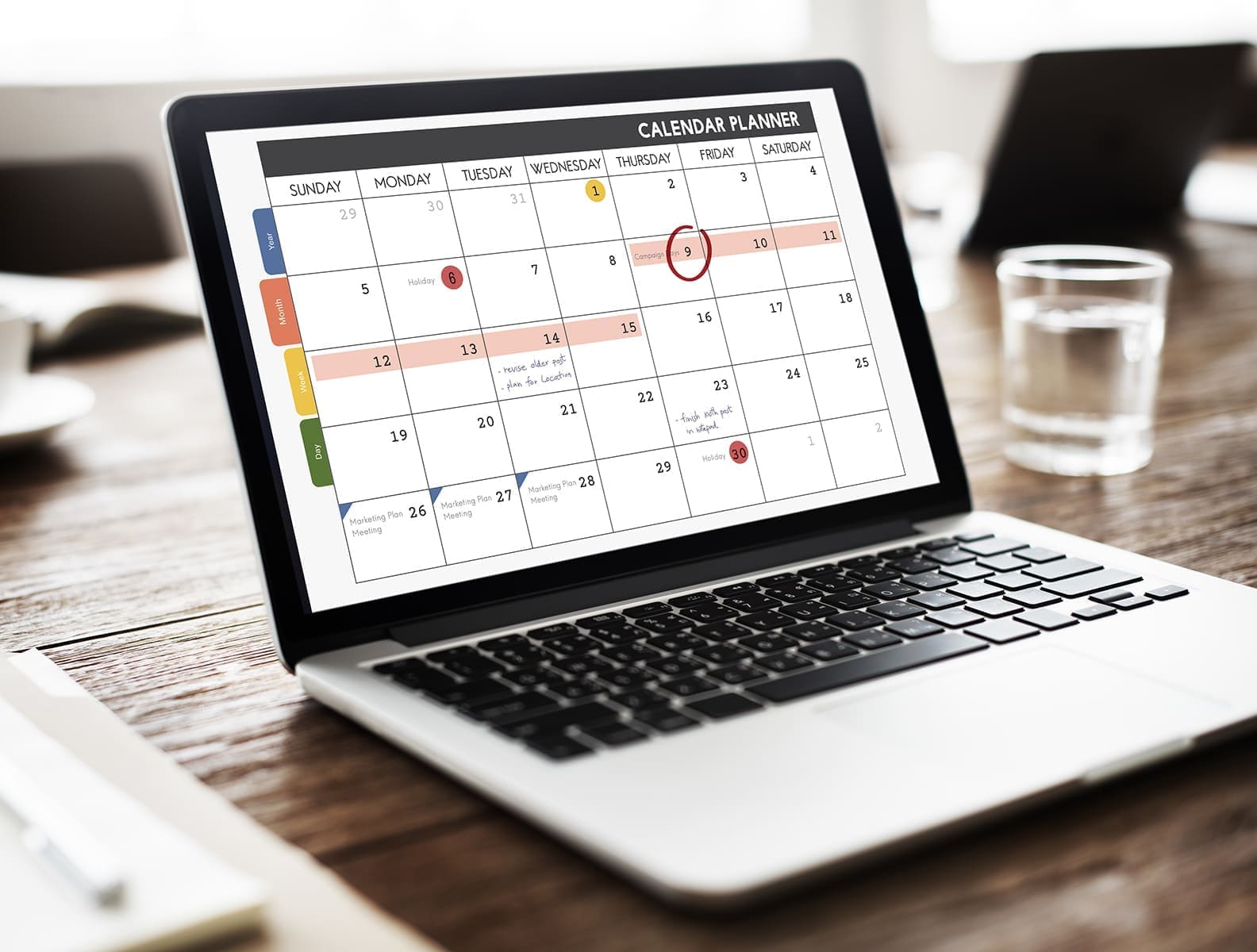
Redegal, Google Partner Premier agency 2025
Social networks are an important tool in digital marketing to achieve the goals set. With a well-organized content calendar everything will be much easier. Here’s how to do it!

Organization is the greatest ally for managing social media. Those common questions like “What do we post tomorrow?” or “Is the strategy working?” can stop tormenting you if you create a content calendar for your social networks.
Calendars have become an essential tool when implementing a digital marketing strategy on social media. Thanks to the planning capacity that they offer, you can create content at the right time and ensure that it impacts the target audience. Additionally, having everything scheduled, there is time to create relevant, attractive, and unique posts that attract the attention of users.
Creating a content calendar for social media may seem like a daunting task, but in this post, we’ll show you that it’s not, and that ultimately, it will save you a lot of time and headaches. There are simple ways to do it that also work and are effective. We invite you to stay until the end to discover them.
Before getting started, it’s important to understand what a social media content calendar entails. It’s a tool for planning, organizing, and scheduling the posts that will be shared across the various social media profiles your company has.
By doing this, you can anticipate your content and develop a strategy to achieve or exceed the goals set in your communication plan. Using it will enable you to manage your social media with a clear strategy, diversify the objectives of your posts, and avoid improvising the company’s communication.
The goal of the calendar is to facilitate the management of social networks. The more detailed it may be, the easier it will be to work with it. Always keeping in mind that we shouldn’t add unrelated or unuseful information. Some of the main categories that will be used to have an overview of the activity that the brand will develop in social networks could be:
As you can see, having a content calendar for social media offers many more advantages than disadvantages.
Organization is always a good work companion and in this case, it will make your life easier. This, among other things, will influence the creative process because it will be done with less pressure and this is how the best ideas emerge.
Next, we’ll tell you about many other benefits of having a calendar for your brand’s social media.
Having time allows for a broader content strategy, making it more effective because it allows a greater analysis and the identification of the best approach to achieve the objectives. This rest is what will make the effort rewarded, as you can’t share content without storytelling and wait for it to go viral at some moment (if it ever happens).
Having all the content collected in a calendar will make it possible to look back, see everything that has been shared and the results that were obtained. This way, you can differentiate what worked well and what didn´t, and from there, adjust the strategy based on this data so that your brand continues on the right track.
Throughout the year, there are many dates marked in red for marketing. We recommend reviewing the calendar and marking all those holidays or themed days that are of interest to your brand. These can be an ideal opportunity to create relevant content to participate in social conversations. This will increase visibility, show that your brand exists, and help attract new followers and potential customers.
Trends come when you least expect them. Having the content that will be shared in the networks well structured and organized in a calendar will make it possible to adapt and see the gaps that remain for new publications more spontaneously.
With a clear and solid strategy, the next step is to work on how to incorporate the trends your target audience is talking about. This will be a good way to improve the reach and engagement of your brand, connect with the audience, and take advantage of the visibility that comes with being up to date.
Rush makes waste, and when something has to be ready in just a few hours, many details that can directly influence your brand’s image are overlooked. Working with a calendar and scheduling content weeks in advance will allow those spelling errors, formatting issues, or broken links to be seen and be resolved calmly.
To ensure that the content calendar for your brand’s social platforms works we recommend following a few steps. Working in this order from the beginning will help to create routines and make the planner less and less expensive.
First of all, we must know what we want to achieve. For example, increase brand visibility, generate more sales for a product, or improve customer loyalty. A tip to establish and achieve the goal is to use SMART methodology that specifies that goals should be:
This will be the starting point because it will mark the base for continuing to work and build your brand plan on social media. The objectives will serve as a guide when decisions have to be made and will mark the next steps.
It’s also important to know your target. From there, it will be easier to discover what to talk about and how to do it to connect with that audience.
One of the tools that can help define the target is creating a buyer persona, which will represent your perfect customer. Some of the criteria to consider when defining this buyer persona are:
This can be complemented with surveys to better understand the audience and also with focus groups.
Although it may seem necessary, it’s not essential to be present on all social media platforms. Each platform has its own characteristics, and it’s important to analyze which platform aligns best with your goals and where your target is located. Other points to consider are that each social media platform requires a different message. It’s possible to share the same content on Facebook, Instagram, X, or TikTok, but it should be tailored specifically to each platform. Also, consider the audience that follows you on all of them because if they perceive that you’re repeating what you share, they may eventually unfollow you on one of the profiles.
It’s essential to optimize time and ensure that each post is meaningful, achieving good results and impact on the audience. To do this, you have to analyze the content that is performing well on social networks at all times. If you do, your brand will make sure what it shares is relevant.
One way to begin analyzing content is by studying what your competitors or brands in your sector are doing and how it’s working for them. This will help generate ideas to make your content calendar effective. However, always remember to keep your brand’s identity and objectives in mind so that communication remains consistent and communicates with its own voice.
Knowing when to publish is important to see how much content to generate. To mark the frequency of publication you can see what hours and days are the best to share content on each social network.
However, we must take into account the resources available to create the content (time, work team, platforms, etc.) and the objectives set. The important thing is consistency and whether the public knows or not to forget that your brand exists.
Organizing content by categories will help make the calendar faster, easier and more efficient. These can be created based on the objectives, themes of your brand, lines of communication strategy or formats of each network.
All this will make the communication that is done in social networks is coherent because it will follow the same line in which your brand is the center and that will help you achieve your business goals.
It is time to generate ideas according to the categories formed. Create a list to write all the ideas that come to your mind, ensuring that all are considered and making it easier to organize them later in the calendar. Also those ideas that you do not use will be saved and available for later, so you will always have options available.
In addition to personal inspiration and with the objective of fine-tuning the content, you can resort to some of these dynamics:
After brainstorming, everything is more prepared to create the content to fill the calendar. Therefore, you need to choose the platform on which the planning will be developed. It could be an Excel spreadsheet or other tools like Notion, Asana, or Hootsuite. You can try several until you find the one that best suits you and is easiest for you to manage.
Those creative designs and witty copies will be transferred from the calendar to the chosen platforms for scheduling content. Some platforms that allow you to create the calendar also enable scheduling various posts. Social media platforms themselves offer advanced options and also provide the option to schedule the day and time of publication for a post.
Once you have published content to analyze, use tracking tools (native or not) to extract insights from the data they provide. You’ll be able to see what the best and worst performing publications have in common and analyze if they are working well based on each other’s goals. With this data, you can refine your strategy over time.
Have any questions? Don’t worry, you can contact us, and we’ll help you create the content calendar that takes your brand to the next level.
You may be interested in our latest posts

Redegal, Google Partner Premier agency 2025

Bluesky: What is it and how to create an effective strategy

The Super Bowl in a data-driven era

Corporate image of a company: What is it and its key elements
Discover the best digital strategies for your brand
Hi!
We are looking forward to hearing more about your digital business.
Tell us... What do you need?
Fill in the form or call us at (+44) 2037691249